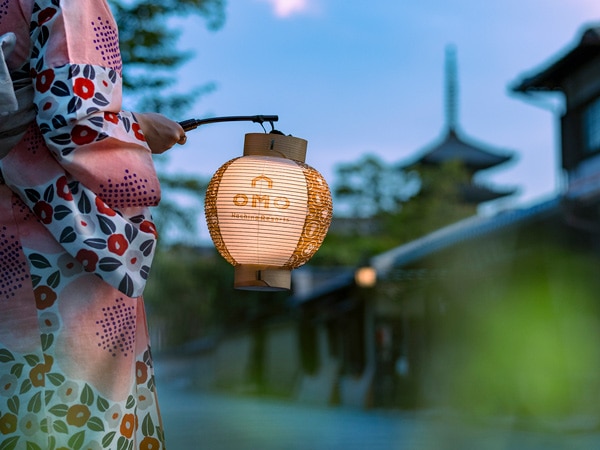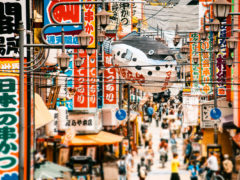How to spend 48 hours in Kyoto


Take part in an authentic tea ceremony. (Image: Kyoto City Tourism Association)
Travel with Christine Aldred as she takes in some highlights in a city that served as the country’s capital for more than 1000 years.
What you might imagine as quintessential Japan – ancient traditions, stunning gardens, historic castles and temples and serene tea houses – all comes beautifully wrapped in one enticing package in Kyoto.
Day one
6.30am
It’s tempting to lounge around your pistachio-green Japanese-styled room at OMO5 Kyoto Gion, a hotel effortlessly combining funk with tradition, but instead, it’s an early start. Join a hotel ‘ranger’ as they guide you through the charming streets of the historic Gion district, conveniently on your doorstep.

Settle in your room at OMO5 Kyoto Gion. (Image: Hoshino Resorts)
It’s a place of stone pavements and preserved timber buildings shuttered with bamboo screens where kimono-clad geiko (geisha) still roam.

Gion is Kyoto’s famed geisha district.
The tour might be in English but if not (and your Japanese isn’t up to scratch), it’s still an opportunity to roam the streets crowd-free, see some highlights and make an offering at Yasaka Shrine.

OMO5 Kyoto Gion is in the cultural heart of the city. (Image: Hoshino Resorts)
8.30am
Don comfy shoes and head towards Kyoto’s eastern mountains in Higashiyama to the Silver Pavilion, a Zen Buddhist temple (that’s not actually silver). Here, you can wander the moss garden and view the meticulously groomed dry sand garden.
Follow the two-kilometre stone Philosopher’s Path along the tree-lined canals as a famed philosopher once did daily. Be rewarded with a profusion of pink cherry blossoms in spring and with glowing reds in autumn. Peek at the fascinating shops and cafes en route as you follow the signs to 13th-century Nanzenji Temple so you don’t disappear into the ’burbs.

Find your zen in the Japanese Garden at Nanzenji temple.
10.30am
There are 74 categories of traditional crafts in Kyoto and the surprisingly modern Kyoto Museum of Crafts and Design is the only place to see them all together. Their intricacies and history are explained through exhibitions, touch panels and videos, and local craftsmen demonstrate their artisan skills five days a week. Embroidery, lanterns, Kyoto bags, masks, fans and tea caddies are just the beginning of the exquisite work on display.

Discover the vibrant Japanese arts and culture at the Kyoto Museum of Craft & Design.
1pm
The scattered assortment of boutiques and galleries in the backstreets of the Gion District, showcasing beautiful stationery, ceramics, paper umbrellas and antiques, are a shopper’s delight. Visit places featured on the huge graphic map in OMO5’s hotel foyer, highlighting places of interest and recommended shops and restaurants nearby, or make your own discoveries.

Admire the Cherry blossom bliss along Gion district.
2.30pm
At Tsujiri Tea House, the shopfront of a tea manufacturer founded in 1860, you’ll find premium teas from nearby Uji, tea confectionery, matcha ice-cream and otherworldly parfaits. Close by at Ousu no Sato, it’s just about plums: pickled, sweet, sour, in jams or wine. Patisserie Gion Sakai dishes up superb cakes, sweets and cookies with a European bent, with a small café upstairs to linger longer.
4pm
Need a pick-me-up? Grab a perfectly roasted espresso coffee at iconic %Arabica, just down from the Yasaka Pagoda, or try its matcha latte for a Japanese twist, but there may be a line. If you prefer tea, at the elegant Camellia Flower Tea House, you can partake in the ritual of an experiential tea ceremony and taste Kyoto’s fabled green matcha whisked to a froth by an expert. Book in advance and add on kimono hire to really get into the spirit.

Take part in an authentic tea ceremony. (Image: Kyoto City Tourism Association)
6pm
Head to Gion Corner for the best of Japanese performing arts, where you will experience seven kinds of traditional performances in less than an hour. If you haven’t spotted geiko or maiko (apprentice geisha) on the streets, you’ll catch one here performing kyo-mai dance or playing the stringed koto. You’ll also get the chance to see puppet theatre, Noh drama and the art of ikebana (flower arrangement).

See performing arts at Gion Corner. (Image: Kyoto City Tourism Association)
7.30pm
Head to Michelin-starred Kentan Horibe to experience the splendour and seasonality of kaiseki dining, a traditional multi-course affair where immaculate presentation and beautiful crockery are just as important as the food. Expect to be wowed.
Day two
8am
With only two days in town, there’s no time to waste. Head south to one of Kyoto’s most impressive sights at the Fushimi Inari Taisha Shinto Shrine, a vast network of striking orange torii gates snaking up the mountain in a seemingly never-ending pathway. The early start will minimise the inevitable crowds. Grab a bite from the food stalls to keep your energy up and take your earphones for an audio guide.

Fushimi Inari Taisha Shrine is a historic Shinto shrine in southern Kyoto. (Image: Kyoto City Tourism Association)
10.30am
Continue two train stops further to step back in time at the historic Fushimi Sake District, the second largest sake brewing area in Japan where rice wines have been brewed since 1637. The 90-minute tour at Kyoto Insider Sake Experience is a great place to start your explorations, including sampling seven sakes, neat and paired with food. It’s a revelation.

The Fushimi sake district is an ancient brewery town in Kyoto. (Image: Kyoto City Tourism Association)
12.30pm
Head back into town to bustling Nishiki Market, stretching five blocks along a narrow, covered passageway in downtown Kyoto for a glimpse into the shopping street’s 400-year history. With more than 100 stalls, it’s a treasure trove of Japanese ingredients and local specialties – pickles, miso, fresh fish, tofu and kelp – as well as lots of things you might not recognise. Grab some grilled skewers, sashimi or octopus on sticks for takeaway lunch or find a seat at a small restaurant.

Explore Nishiki Market, also known as Kyoto’s Kitchen. (Image: Kyoto City Tourism Association)
3.30pm
What’s a trip to Kyoto without a castle? The massive stone walls and ramparts of World Heritage-listed Nijo Castle speak to the power of the shoguns (warlords) who resided there for centuries. Within the complex, the opulent Ninomaru Palace features intricate woodcarvings, extravagant art and liberal splashings of gold leaf in an overt display of wealth. Try to silently navigate the timber ‘nightingale floors’ designed to ‘sing’ under the feet of intruders and wander the expansive classical gardens (three of them) featuring ponds, islands, cherry trees and manicured pines.

Visit Nijo Castle, which was built in 1603 as the Kyoto residence of the first shogun of the Edo Period. (Image: Kyoto City Tourism Association)













LEAVE YOUR COMMENT